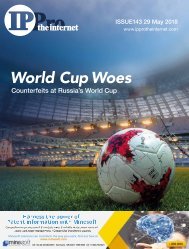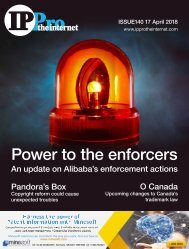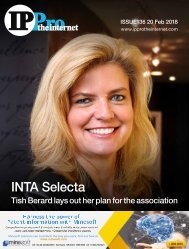IPPro Patents Issue 049
In this issue: Andrei Iancu confirmed as USPTO director
In this issue: Andrei Iancu confirmed as USPTO director
Create successful ePaper yourself
Turn your PDF publications into a flip-book with our unique Google optimized e-Paper software.
Case Report<br />
However, the court was not persuaded by Ericsson’s arguments to<br />
reject Concur IP’s analysis and used the number of industry-wide<br />
SEPs determined by Concur IP and Dr Ding, after some adjustments,<br />
as the denominator for the top down calculation.<br />
Contribution count not an indicator of patent portfolio strength<br />
Ericsson proposed the use of technical contribution counting as a<br />
means to determine the strength of its portfolio.<br />
The court rejected the idea citing two major flaws: a lack of<br />
correspondence between technical contributions and patents, and<br />
its inability to account for transferred and expired patents.<br />
Importance of individual patents difficult to quantify<br />
TCL experts analysed the importance and contribution of Ericsson<br />
SEPs and used the analysis to calculate a value share for Ericsson’s<br />
SEPs relative to the value-distribution of all SEPs in the standard.<br />
While the court did find some value in the importance and contribution<br />
analysis, particularly to show that Ericsson’s patent portfolio is<br />
certainly not as strong or essential as it has claimed, it found the<br />
application of this analysis to calculate the overall rates too flawed<br />
to be used.<br />
The court cited three flaws:<br />
Lack of similar analysis on rest of the SEPs for comparison with<br />
importance and contribution of Ericsson’s SEPs<br />
Lack of analysis on whether the alternatives identified for various<br />
Ericsson SEPs would be mutually consistent with each other,<br />
who owned the alternatives, whether the alternatives were<br />
unpatented, expired, or part of a previous standard<br />
Lack of justification to map specific importance and contribution<br />
ratings to quantifiable values<br />
Broad interpretation of similarly situated firms<br />
The court took a broad interpretation of similarly situated firms and<br />
found Apple and Samsung to be similarly situated as TCL for licence<br />
comparison along with Huawei, LG, HTC, and ZTE.<br />
The court made following observations in this regard:<br />
Sales volume alone does not justify giving lower rates to otherwise<br />
similar firms<br />
Factors such as the firm’s overall financial success or risk,<br />
brand recognition, the operating system of their devices, or the<br />
existence of retail stores have no bearing on whether Ericsson’s<br />
royalty rates for its SEPs are discriminatory<br />
Local kings, such as Karbonn and Coolpad, are not similarly<br />
situated to TCL<br />
Competitive harm to a firm sufficient to prove discrimination<br />
While Ericsson argued that discrimination must have the effect of<br />
impairing the development or adoption of standards, the court took<br />
a much broader view and found that harm to the competitor firm<br />
offered discriminatory rate is sufficient to prove discrimination.<br />
Impact on future SEP licences<br />
It would be interesting to see how this judgement and the underlying<br />
findings impact SEP licences going forward, both new licences<br />
(particularly for the upcoming 5G technology) and the existing ones<br />
when they are up for renewal. Are we going to see another series<br />
of disputes when licensees at the higher end of the range try to<br />
negotiate rates closer to the ones determined by the court or will<br />
the SEP owners and implementers develop an understanding and<br />
commonly agreed upon rate? If one goes by the history, the latter<br />
looks less likely.<br />
Patent portfolios are dynamic due to acquisition and sale, as well as<br />
filing of new patent applications, and so will be the FRAND rate for each<br />
of these portfolios. This will give both SEP owners and implementers<br />
opportunity to renegotiate the rates once the existing licences end.<br />
The approach adopted by the court for royalty calculation is certainly<br />
going to play an important role in future SEP licenses.<br />
Particularly, the top down approach may gain more popularity<br />
going forward. The cellular industry has been demanding more<br />
transparency in royalty rate setting and this judgement will go a long<br />
way in addressing that. <strong>IPPro</strong><br />
The cellular industry has been<br />
demanding more transparency in royalty<br />
rate setting and this judgement will go a<br />
long way in addressing that<br />
Sachin Sinha, co-founder, Concur IP<br />
23 <strong>IPPro</strong> <strong>Patents</strong>







